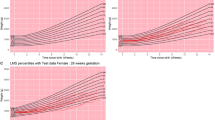Abstract
Growth charts are used in pediatric medicine to plot anthropomorphic measurements over time, serving as a screen for diseases related to a patient's nutritional and general health status. Whereas reference data for term infants are available from the Center for Disease Control, reference data for premature infants in a neonatal intensive care unit have not been established. Predictive curves for preterm patients, which are based on a patient's postmenstrual age and anthropomorphic measurements at birth, cannot be easily implemented with traditional paper-based methods. Preterm growth charts can be generated in an electronic health record system, but doing so requires mathematical equations or computer-readable tables. This report examines published perinatal growth curves and presents equations for predicted postnatal weight, head circumference and length in preterm infants.
This is a preview of subscription content, access via your institution
Access options
Subscribe to this journal
Receive 12 print issues and online access
$259.00 per year
only $21.58 per issue
Buy this article
- Purchase on Springer Link
- Instant access to full article PDF
Prices may be subject to local taxes which are calculated during checkout





Similar content being viewed by others
References
Ogden CL, Kuczmarski RJ, Flegal KM, Mei Z, Guo S, Wei R et al. Centers for Disease Control and Prevention 2000 growth charts for the United States: improvements to the 1977 National Center for Health Statistics version. Pediatrics 2002; 109 (1): 45–60.
Kuczmarski RJ, Ogden CL, Grummer-Strawn LM, Flegal KM, Guo SS, Wei R et al. CDC growth charts: United States. Adv Data 2000; 314: 1–27.
Lubchenco LO, Hansman C, Dressler M, Boyd E . Intrauterine growth as estimated from liveborn birth-weight data at 24 to 42 weeks of gestation. Pediatrics 1963; 32: 793–800.
Lubchenco LO, Hansman C, Boyd E . Intrauterine growth in length and head circumference as estimated from live births at gestational ages from 26 to 42 weeks. Pediatrics 1966; 37 (3): 403–408.
Usher R, McLean F . Intrauterine growth of live-born Caucasian infants at sea level: standards obtained from measurements in 7 dimensions of infants born between 25 and 44 weeks of gestation. J Pediatr 1969; 74 (6): 901–910.
Babson SG, Benda GI . Growth graphs for the clinical assessment of infants of varying gestational age. J Pediatr 1976; 89 (5): 814–820.
Fenton TR . A new growth chart for preterm babies: Babson and Benda's chart updated with recent data and a new format. BMC Pediatr 2003; 3 (1): 13.
Steward DK, Pridham KF . Growth patterns of extremely low-birth-weight hospitalized preterm infants. J Obstet Gynecol Neonatal Nurs 2002; 31 (1): 57–65.
American Academy of Pediactrics Committee on Nutrition: Nutritional needs of low-birth-weight infants. Pediatrics 1985; 75 (5): 976–986.
Macdonald PD, Ross SR, Grant L, Young D . Neonatal weight loss in breast and formula fed infants. Arch Dis Child Fetal Neonatal Ed 2003; 88 (6): F472–F476.
Dancis J, O'Connell J, Holt LJ . A grid for recording the weight of premature infants. J Pediatr 1948; 33: 570–572.
Brosius KK, Ritter DA, Kenny JD . Postnatal growth curve of the infant with extremely low birth weight who was fed enterally. Pediatrics 1984; 74 (5): 778–782.
Gill A, Yu VY, Bajuk B, Astbury J . Postnatal growth in infants born before 30 weeks' gestation. Arch Dis Child 1986; 61 (6): 549–553.
Shaffer SG, Quimiro CL, Anderson JV, Hall RT . Postnatal weight changes in low birth weight infants. Pediatrics 1987; 79 (5): 702–705.
Wright K, Dawson JP, Fallis D, Vogt E, Lorch V . New postnatal growth grids for very low birth weight infants. Pediatrics 1993; 91 (5): 922–926.
Ehrenkranz RA, Younes N, Lemons JA, Fanaroff AA, Donovan EF, Wright LL et al. Longitudinal growth of hospitalized very low birth weight infants. Pediatrics 1999; 104 (2, Part 1): 280–289.
Pauls J, Bauer K, Versmold H . Postnatal body weight curves for infants below 1000 g birth weight receiving early enteral and parenteral nutrition. Eur J Pediatr 1998; 157 (5): 416–421.
Berry MA, Conrod H, Usher RH . Growth of very premature infants fed intravenous hyperalimentation and calcium-supplemented formula. Pediatrics 1997; 100 (4): 647–653.
NICHD Neonatal Research Network. National Institutes of Child Health and Human Development. Very low birth weight (VLBW) postnatal growth charts. http://neonatal.rti.org/birth_curves/dsp_BirthCurves.cfm(accessed 22 November 2004).
Giuse DA, Mickish A . Increasing the availability of the computerized patient record. Proc AMIA Annu Fall Symp 1996; 633–637.
Engle WA . Age terminology during the perinatal period. Pediatrics 2004; 114 (5): 1362–1364.
Patel AL, Engstrom JL, Meier PP, Kimura RE . Accuracy of methods for calculating postnatal growth velocity for extremely low birth weight infants. Pediatrics 2005; 116 (6): 1466–1473.
Styles ME, Cole TJ, Dennis J, Preece MA . New cross sectional stature, weight, and head circumference references for Down's syndrome in the UK and Republic of Ireland. Arch Dis Child 2002; 87 (2): 104–108.
American Academy of Pediatrics: Task Force on Medical Informatics. Special requirements for electronic medical record systems in pediatrics. Pediatrics 2001; 108 (2): 513–515.
Rosenbloom ST, Qi XF, Riddle WR, Russell W, DonLevy SC, Giuse D et al. Pediatric growth charts implemented via an electronic health record system. J Am Med Inform Assoc (accepted on 11 January 2006).
Acknowledgements
This work was supported in part by 1 K22 LM08576-01 (Rosenbloom).
Author information
Authors and Affiliations
Corresponding author
Rights and permissions
About this article
Cite this article
Riddle, W., DonLevy, S., Qi, X. et al. Equations to support predictive automated postnatal growth curves for premature infants. J Perinatol 26, 354–358 (2006). https://doi.org/10.1038/sj.jp.7211511
Received:
Revised:
Accepted:
Published:
Issue Date:
DOI: https://doi.org/10.1038/sj.jp.7211511
Keywords
This article is cited by
-
Maternal childhood trauma is associated with offspring body size during the first year of life
Scientific Reports (2022)
-
Poor weight gain and its predictors among preterm neonates admitted at Muhimbili National Hospital in Dar-es-salaam, Tanzania: a prospective cohort study
BMC Pediatrics (2021)
-
How Fast Should the Preterm Infant Grow?
Current Pediatrics Reports (2013)
-
Calculating postnatal growth velocity in very low birth weight (VLBW) premature infants
Journal of Perinatology (2009)



